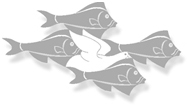

|
|
The Peripheral Systems Lab aims at creating and exploring new paradigms in fields related to color imaging and media servers. The main focus of our research is directed towards novel imaging techniques (color prediction models, color reproduction, artistic imaging, moiré theory and images, anti-counterfeiting). We are also creating new paradigms for exploring human anatomy (Visible Human) and are developing a fault-tolerant framework for the creation of non-trivial parallel programs running on clusters of PCs.
Colour Reproduction
We have developed several
spectral prediction models for predicting the spectra of halftone patches. They work well for offset prints,
thermal transfer and ink-jet printers, see also [Emmel00]. These models take into account
the most important physical phenomena such as surface reflections, internal
Fresnel reflections at the paper-air interface, light propagation within the paper bulk and ink spreading.
Advanced color separation and halftoning techniques have been developed for protecting documents printed with
custom inks [Ostromoukhov99a], [Chosson01] or with metallic inks [Hersch03].
In order to facilitate the creation of banknote designs to be printed with
non-standard inks, we have also explored techniques for the gamut
reduction of color images [Chosson02].
Microstructure Imaging
Microstructure imaging enables synthesizing images incorporating visually
appealing microstructures. Microstructures are graphic objects specially
designed to convey their own message. The microstructure encrustation
techniques we have developed rely on the automatic creation of dither
matrices or on chromatic color differences [Rudaz04]. Microstructures
can be seen by the naked eye, by a magnifying glass or as a moiré
revealed by a dot screen or a micro-lens array. Microstructures are being
used by the industry for producing remotely printable
secure event entry and travel tickets.
The Moiré Phenomenon
A thorough
Fourier-based model of the moiré phenomenon has been established, which can be
used for both the analysis and synthesis of
moiré effects. It provides a full qualitative and
quantitative understanding of the moiré effect and has been applied
to document authentication and anti-counterfeiting. The
book, The Theory of the Moiré Phenomenon by
I. Amidror (published by Kluwer Academic Publishers, 1999) provides a
comprehensive introduction to the moiré theory and includes our
main research results.
High-performance imaging servers
We created a framework for facilitating the development of parallel applications
on PC clusters [Gerlach03]. This framework allows to define dynamic parallel
schedules (DPS) , which support compositional customizable split-compute-merge
graphs of operations (directed acyclic flow graphs). The graphs and the mapping
of operations to processing nodes are specified dynamically at runtime. DPS
applications can call parallel services exposed by other DPS applications,
enabling the creation of reusable parallel components. Currently a version of DPS supporting graceful degradation in case of node failures is being developed. This fault-tolerant version of DPS should become available in spring or summer 2005.
Applications include the Visible Human Server running on PCs offering
real-time slicing [Gerlach02], anatomic organ construction and visualization
[Evesque02] as well as the specification, extraction and flattening of curved
surfaces [Saroul03].
Digital typography
Methods were developed for the generation of
perceptually-tuned grayscale characters improving the
readability of LCD displays. Methods have also been created for
generating typographic characters made of parametrisable components. The
component-based font synthesizing system
enables generating fonts with variations in condensation, weight and
contrast [Hu01]. Since fonts are merely described by parameters, they require an
order of magnitude less storage space than conventional outline based font
descriptions. The book Visual and technical Aspects of Type
gives information about various typographic issues.
Director: Prof. Roger D. Hersch (+41 21 693 43 57 ou RD.Hersch@epfl.)
Secretariat: Ms Fabienne Allaire (+41 21 693 66 45)
Fax: +41 21 693 66 80
The Peripheral Systems Laboratory is part of the School of Computer and Communication Sciences of the Ecole Polytechnique Fédérale de Lausanne.